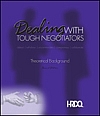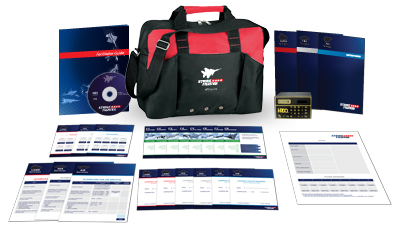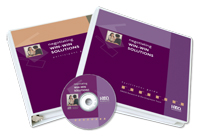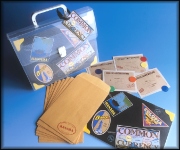|
Negotiating Skills
The Negotiating Style Profile is a win-win, collaborative negotiating assessment for employee and management development training to improve negotiating skills. The assessment identifies a preference for 1 of 5 negotiating styles based on the William Ury and Roger Fisher’s win-win model of negotiating, and the Thomas-Kilmann conflict resolution model.
The Negotiating Style Profile is a great starting point. Based on Ury and Fisher’s collaborative win-win model, and heavily influenced by the Kilmann-Thomas conflict resolution model, The Negotiating Style Profile offers a simple framework for determining one’s negotiating style and the likely effect of that style in a negotiating situation. Both professionals and non-professionals will find the Negotiating Style Profile to be a valuable tool for improving negotiating skills. First, individuals identify their preference for 1 of 5 negotiating styles: Defeating, Accommodating, Collaborating, Withdrawing, or Compromising. Next, observer feedback provides valuable insight from peers. Finally, they learn how to use this knowledge to focus on the skills and methods that are likely to produce synergistic outcomes. LEARN more ay HRDQ,
Learning Outcomes:
Understand 5 styles of negotiating. Identify personal negotiating characteristics. Learn why a win-win approach is most effective. Gather peer feedback about one’s negotiating style.
Theory and Development : The Model of Negotiating Styles at the center of Negotiating Style Profile is based on relevant literature on negotiating practices, including Getting to Yes, by Roger Fisher and William Ury. These sources reveal that concerns for both the outcome of the negotiation and for the relationship appear to represent the most important behaviors a negotiator can employ in an actual negotiation. The Negotiating Style Profile also references the research of Thomas and Kilmann (1976) because the negotiating model bears similarities to the conflict resolution process, which suggests that a particular resolutions style can be predicted based upon a person’s willingness to confront issues and willingness to see all points of view. The Thomas-Kilmann model describes five pure styles for conflict resolution. This same approach can be used to describe the five styles of negotiating behavior. Drawing from the literature on conflict resolution, it is clear that a negotiator cannot be effective in both the short and long terms if he or she emphasizes one set of concerns to the exclusion of the other. Although variations of each of the 5 Characteristic Negotiating Styles may be appropriate under certain conditions, it is suggested that a consistent application of the Collaborate style offers the greatest probability of producing the highest quality negotiating results and the most enduring satisfaction to the parties involved. Salary and Sales Negotiation Training: Reading Body Language
There's a lot to learn in sales negotiation training, but nothing can beat knowing the other party's position. Learning to read body language can give you that edge. But that's not all. Negotiating experts say that you'll get better result with the other person you're negotiating with, if they like you.
Sales Negotiation Training: Reading Body language Many of us negotiate every day, both in business and personal interactions. All of these negotiations involve 2 critical factors: the outcome and the relationship that exists between the negotiators. In an increasingly fast-paced and competitive marketplace, we can’t afford to jeopardize either. For building the skill set needed to foster partnerships and achieve favorable agreements, NegotiatingSuccess™ is the solution. Based on the well-known collaborative model of negotiating behavior, this powerful 2-day program takes the fear out of negotiating, helping individuals to prepare for negotiations, find creative solutions to tough problems, work through personal style differences, and build relationships with negotiating partners. Learning Outcomes:
Learn and practice the collaborative discussion model for negotiating. Discover one’s negotiating style and compare it to other styles. Learn how to prepare quickly and accurately for any negotiation. Improve the interpersonal skills needed to support a collaborative negotiating style.
Develop the ability to problem solve with difficult negotiators. Discover one’s communication style and learn how to adapt it to other styles. Create a personal action plan for improving negotiating skills
NegotiatingSuccess includes all the materials you need to conduct a powerful learning event — from pre-work to participant and facilitator support materials. Every HRDQ Program offers just the right mix of interactive tools, helping participants learn compelling concepts, reflect on relevant experiences, and practice new skills.

Many of us negotiate every day, both in business and personal interactions. All of these negotiations involve 2 critical factors: the outcome and the relationship that exists between the negotiators. In an increasingly fast-paced and competitive marketplace, we can’t afford to jeopardize either. For building the skill set needed to foster partnerships and achieve favorable agreements, NegotiatingSuccess™ is the solution. Learning Outcomes: You can't turn a tough negotiator into a collaborative, problem-solving partner. But you can achieve win-win outcomes if you apply the right negotiating techniques. HRDQ's Dealing with Tough Negotiators series will help your negotiators develop the skills they need. This 30-item assessment helps respondents identify their areas of strength and weakness in 5 key negotiating skill areas: Maintaining Composure, Developing Data, Refocusing the Discussion, Being Creative, and Handling Information Strategically. Dealing with Tough Negotiators is based on a study of the relevant literature and the Model of Negotiating Behavior. The literature on collaborative negotiating points to 5 skills that move a negotiation back to constructive, objective discussion. These skills prepare the collaborative negotiator for both offense (proactive collaboration) and defense (wariness, solid research, and constant questioning). The 5 negotiating skills are: Maintaining Composure How It Works With a particular situation and difficult negotiator in mind, participants respond to the 30 statements on the assessment. Participants then learn about the Model of Negotiating Behavior, score the assessment, and chart the results for each of the 5 negotiating skill sets. Interpretive information provides insight on scores and thought-provoking questions help participants think of ways to practice the 5 skills. Following the assessment, the Dealing with Tough Negotiators Workbook offers practice in applying the skills with the help of examples, prepared questions, and guidelines — the perfect tool for negotiators who are about to enter into a particularly difficult negotiation. Uses for Dealing with Tough Negotiators Are about to enter into a particularly difficult negotiation. Routinely face tough negotiating partners.
Have become set in their negotiating tactics and need a refresher. Are familiar with collaborative negotiation, but lack the means to achieve it.
When it comes to negotiating, being “nice” doesn’t have to mean losing — or being the only one to benefit, either. In a world where we’ve been trained and rewarded to compete and win, the Negotiating Win-Win Solutions program attempts to reverse the win-lose perspective and provide a problem-solving approach to negotiation that helps each person involved in the negotiation to walk away feeling like a winner. Negotiating Win-Win Solutions gives participants a framework for conducting collaborative negotiations. Using an interactive format that includes an assessment, a hands-on game, and small group activities, participants learn about negotiating styles and practice a 5-step “win-win” formula to achieve the best outcomes. Learning Outcomes:Pinpoint one’s typical negotiating style. Understand the 5 negotiating styles. Learn 5 factors to consider when preparing for any negotiation. Develop the essential interpersonal skills to use for collaborative negotiating. Apply the skills of collaborative negotiating to real-life situations.
Theory; Negotiating Win-Win Solutions is based on a collaborative model of negotiating. The workshop shows the influences of relevant literature on negotiating practices, including Getting to Yes: Negotiating Agreement Without Giving In by Roger Fisher and William Ury. How It Works: The program gives participants a well-rounded learning experience, balancing facilitator instruction with group interaction and private reflection. Through a combination of HRDQ tools including an assessment, a hands-on game, and small group activities, participants gain insight and practice collaborative negotiating skills. The session culminates with action planning — helping participants to apply the learning to actual work-related situations. Uses for Program: Negotiating Win-Win Solutions is appropriate for individuals at all levels who are involved in typical negotiations. The program’s flexible training design allows facilitators to present Negotiating Win-Win Solutions in one day or 2 half-days, or combine the program with other training sessions to create an expanded learning experience.
Common Currency Game Is it really possible to practice the strategies of competition and cooperation at the same time? Yes! Around the world, production teams, research and development groups, and marketing teams all are benefiting from the power of cooperative-competition. Discover for yourself this fresh approach to individual, team, and organizational development with Common Currency: The Cooperative Competition Game. Teams representing fictional countries must cooperate in trading coins and information while competing for the most valuable combination of coins. When to use Common Currency This game is a flexible, team-based activity that utilizes a wealth of interpersonal and group-process skills. We especially like using it as part of negotiating and strategic planning workshops. But it’s ideal for a wide array of training topics. The Facilitator Guide includes debriefs for training in team building, communication, negotiating, strategic planning, decision making, problem solving, resource sharing, and more. Also included is a separate change module, which demonstrates the value of cooperative-competition in times of change. Development of the Game The idea for Common Currency came about as the author was exploring the effects of competition on team building. She discovered that very few people were aware of the beneficial nature of competition within a collaborative environment, so she decided to create a game that would demonstrate those benefits.
To further limit these resources, the coins and cards were to be randomly distributed in small portions to each participating group. Therefore, teams would have diverse assortments of coin values and pieces of information. In an attempt to gain the most valuable coin collection, participants would need to cooperate within their own team as well as negotiate with other groups for information and coins. The resulting interactions would establish the basis for the debriefing topics.
Building Negotiating Power Participants will learn the benefits of collaborative negotiating style, the 6 rules of successful negotiation, how to handle conflict, and how to handle conflict, and how to ensure satisfactory follow-through. learn more at HRDQ now.Click here to visit HRDQ 
Simulated negotiation. Real-world skills.Strike fighter. If you think negotiations are a battle to be won, imagine this…
You know firsthand what the Air Service needs in its aircraft – heck, you’ve flown the covert operations yourself. Now, as the military Commander of the Air Service, you’re about to take part in the most challenging mission of all: a top-secret meeting with the Heads of the Land and Sea Services to replace an aging fleet of strike fighter jets with just a single model. While you want to fight for the sole interests of the Air Service, you know it could cause you to win the battle… but lose the war. Instead, you must engage your well-honed negotiating skills and collaborate. Practice makes perfect. Learning Outcomes Practice the negotiation process and reflect upon their negotiating skills Understand and explain the characteristics of the five main negotiating styles: Defeat, Withdraw, Accommodate, Compromise, and Collaborate Reassess and improve upon their negotiating style Create a personal action plan for improving their negotiating skills Uses for the Simulation
Strike Fighter is effective as a stand-alone activity or as part of a more comprehensive training program. Here are some suggested applications for the simulation: Introduction to the concept of collaborative negotiating. An experiential follow up to the Negotiating Style Profile assessment. Basic negotiating skills practice. Preparation exercise for sales people or purchasing agents.Team building activity for teams that need to collaborate. What to Order
The Strike Fighter Complete Kit provides you with everything you need to train up to 48 people, including a comprehensive Facilitator Guide, card decks, worksheets, and more. Our Client Solutions Team is happy to assist you in determining your materials needs. Go to HRDQ store now.
If you are new to Strike Fighter, we highly recommend HRDQ QuickStart Training, whether you are a novice trainer or a seasoned facilitator. It’s an excellent way to quickly get up to speed on the simulation so you can step into your first training class with confidence. Personalized, one-on-one telephone coaching is provided at your convenience. Our subject matter experts will review Strike Fighter with you, offer ideas for tailoring the game to your specific needs, discuss typical participant questions and reactions, and more.
Pracownia Gier Szkoleniowych (PGS) PGS designs, develops, and facilitates management development games and business simulations for both global corporations and the non-profit sector. With more than two dozen experts on board, PGS specializes in the fields of change management, communication, and teambuilding.
About NASAGA and the Game Design Competition The North American Simulation and Gaming Association (NASAGA) is a community trainers, educators, game designers, coaches and facilitators who focus on the design and implementation of serious games, simulations, and other experiential activities. In 2009, they introduced the Game Design Competition at their annual conference in Washington, D.C. The purpose of the competition is to encourage and reward innovation in game design and application:
|










